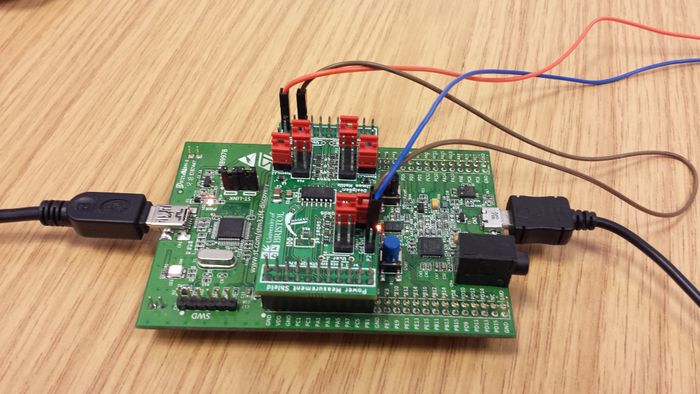Difference between revisions of "Power Measurement Board"
(→How accurate is the board: 12-bit ADC) |
|||
| (2 intermediate revisions by the same user not shown) | |||
| Line 1: | Line 1: | ||
| − | + | MAGEEC needs to carry out a huge number of energy measurements, which requires using many target machines at once. This in turn requires many sets of energy measurement kit. Existing general purpose tools were far too expensive, so we designed our own. | |
| − | |||
| − | + | <center> | |
| − | < | + | [[File:Energymonitor1.jpg|700px|Image of the Energy Monitor]] |
| − | File: | + | </center> |
| − | + | ||
| − | </ | + | Full details are provided in the [[workshop]] on using the board. |
| − | ==Design of | + | ==Design of the energy measurement board == |
| − | + | The board was designed by Simon Hollis at the University of Brsitol as an add-on PCB for the STM32F4DISCOVERY development board from ST Microelectronics. | |
The add-on operates very much like the common 'shield' concept, as popularised by other platforms. It is designed specifically to require no user build or soldering: it is plug-on. | The add-on operates very much like the common 'shield' concept, as popularised by other platforms. It is designed specifically to require no user build or soldering: it is plug-on. | ||
| − | Details on the construction of this board can be found in [[Deliverable 3.1]] and [[Deliverable 3.2]] | + | Details on the construction of this board can be found in [[Deliverable 3.1]] and [[Deliverable 3.2]]. |
| + | |||
| + | === How accurate is the board === | ||
| + | |||
| + | The design goal was to achieve a measurement accuracy of 1%. To date this has not been validated, although experimental results seem to be at least reproducible to this level of accuracy. | ||
| + | |||
| + | The board uses the 12 bit ADCs on the STMF4 discovery board to convert measurements to digital values. To measure the current, the inserted resistor aims to create a maximum 50mV drop. The largest resistor on the board is 5R, which would therefore be for a peak current of 10mA. There is an option to insert a larger resistor if desired. Voltage range is fixed at 0-6V. | ||
| + | |||
| + | The circuit was designed to sample at up to 2MHz on each sample point, although at higher frequencies we would expect inductive and capacitive effects to impact on the accuracy. The standard tool is written in | ||
| + | Python and will sample at up to around 10kHz. To achieve higher sampling rates, the tool and/or firmware (which is fully open) will need modification. | ||
| + | |||
| + | == Legacy Boards == | ||
| + | |||
| + | The current design is now the fourth iteration. It drew on our experience with earlier boards. Here is a [http://youtu.be/mpEI5E8gyec video] of the very first board, which had a single measurement point. | ||
| + | |||
| + | These photos show the shield unmounted and mounted: | ||
| + | <gallery> | ||
| + | File:Energy_Shield.jpg|Energy Monitoring Shield | ||
| + | File:Energy_Shield_on_F4.jpg|Energy Monitoring Shield attatched to an ARM STM32F4 board | ||
| + | </gallery> | ||
[[Category:Media]] [[Category:Design]] | [[Category:Media]] [[Category:Design]] | ||
Latest revision as of 10:03, 7 March 2018
MAGEEC needs to carry out a huge number of energy measurements, which requires using many target machines at once. This in turn requires many sets of energy measurement kit. Existing general purpose tools were far too expensive, so we designed our own.
Full details are provided in the workshop on using the board.
Design of the energy measurement board
The board was designed by Simon Hollis at the University of Brsitol as an add-on PCB for the STM32F4DISCOVERY development board from ST Microelectronics.
The add-on operates very much like the common 'shield' concept, as popularised by other platforms. It is designed specifically to require no user build or soldering: it is plug-on.
Details on the construction of this board can be found in Deliverable 3.1 and Deliverable 3.2.
How accurate is the board
The design goal was to achieve a measurement accuracy of 1%. To date this has not been validated, although experimental results seem to be at least reproducible to this level of accuracy.
The board uses the 12 bit ADCs on the STMF4 discovery board to convert measurements to digital values. To measure the current, the inserted resistor aims to create a maximum 50mV drop. The largest resistor on the board is 5R, which would therefore be for a peak current of 10mA. There is an option to insert a larger resistor if desired. Voltage range is fixed at 0-6V.
The circuit was designed to sample at up to 2MHz on each sample point, although at higher frequencies we would expect inductive and capacitive effects to impact on the accuracy. The standard tool is written in Python and will sample at up to around 10kHz. To achieve higher sampling rates, the tool and/or firmware (which is fully open) will need modification.
Legacy Boards
The current design is now the fourth iteration. It drew on our experience with earlier boards. Here is a video of the very first board, which had a single measurement point.
These photos show the shield unmounted and mounted:


